COVID-19 Outbreak – When Will It End and How to End It
As of April 3, 2020, there have been 275,586 confirmed COVID-19 cases in the United States, a sharp rise from 101,657 just a week ago. According to Johns Hopkins University’s Coronavirus Resources Center, the confirmed cases have reached 1,095,917 globally, from 593,291 a week ago. Most of the states in the US are under shelter-in-place orders, and so are many countries around the world. The confirmed cases in Santa Clara, the hardest hit county in the Bay Area, grew from 155 on March 17, the day shelter-in-place started, to 1,094 on April 3. The shelter-in-place order might have prevented an explosive growth of the outbreak but is not effective in stopping the spread of the disease. The original three-week shelter-in-place order in the San Francisco Bay Area has been extended for another four weeks. Close to 10 million people in the US filed for unemployment claims in the last two weeks of March. In this paper, the COVID-19 case growth rate and its relationship to testing is analyzed for several severely hit countries and regions. The results show that per capita testing number is not a good measure to determine whether testing is sufficient. Testing number should be ramped up until test positivity rate is below 2% to contain the spread of COVID-19. This is more effective than shelter-in-place.
The explosive spread of COVID-19 around the world is likely exacerbated by the vast number of infected people with mild or no symptoms. According to a study, scientists have estimated that 85% of people infected by COVID-19 are undocumented because their symptoms are minor and so do not require medical attention. However, these people with mild or no symptoms can still infect others. In fact, the study estimated that 79% of confirmed cases are infected by undocumented sources. Another study also pointed out that some infected people can start to spread the virus 1-3 days before the onset of symptoms. This is a key factor in finding ways to contain the COVID-19.
Figure 1 shows the confirmed COVID-19 cases in selected countries and regions after 100 confirmed cases based on data published by Johns Hopkins University as of April 3, 2020.
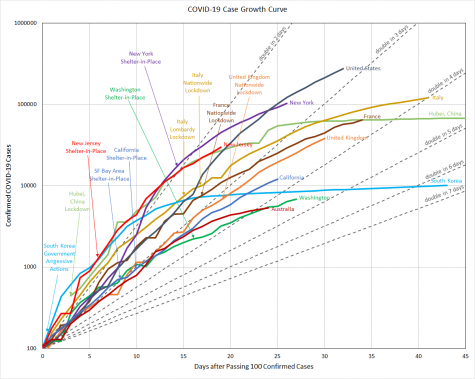
The countries and regions exhibiting explosive COVID-19 outbreaks have confirmed cases doubling every two to three days. South Korean government isolated the infected and ramped up testing immediately after a massive outbreak in a church community. The growth of the confirmed cases slowed down after 10 days without a nationwide lock-down. South Korea continued to ramp up testing and the daily test positivity rate has been less than 1.5% since 20 days after the massive outbreak started, and the confirmed case count has been stable with about 100 new cases per day. Italy, on the contrary, still has more than 4,000 daily new confirmed cases even after 25 days into lock-down. This difference could be attributed to the amount of COVID-19 testing in each country.
Figure 2 shows COVID-19 testing versus confirmed cases per million population.
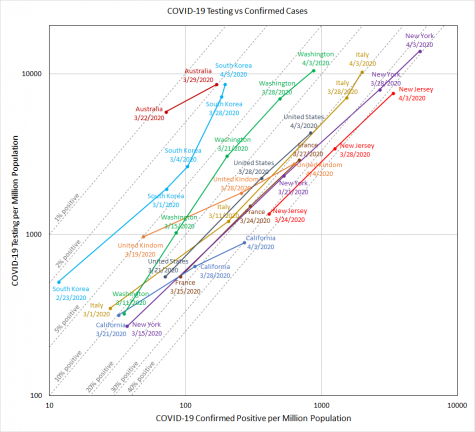
The Australian government has maintained a high rate of COVID-19 testing since the beginning of the outbreak. The overall test positivity rate is only 2%. The majority of confirmed cases were people infected in foreign countries. Australia did not need to implement lockdown to control the community spread. The high level of testing catches the infected people with mild or no symptoms and cuts the spread of the virus. South Korea tested 11,173 cases for COVID-19 with a 0.5% positivity rate before the explosive community outbreak on February 20, 2020. In comparison, according to the CDC, the US tested a total of 2,325 cases by that time. During the peak of the explosive outbreak, the South Korean government quickly increased the COVID-19 testing capacity to catch up with the positive case count. As shown in Figure 3, when the daily testing ramped up to 18,000, the daily confirmed case growth rate dropped from 30% to less than 10% and continued to drop to about 1%. The daily positivity rate peaked at 10% and then dropped below 5% when daily testing reached 18,000 and continued to drop to 1% within three weeks from the start of the massive outbreak. The massive testing of the population was key to identify the people infected by COVID-19 but with mild or no symptoms to cut down the spread of the disease.
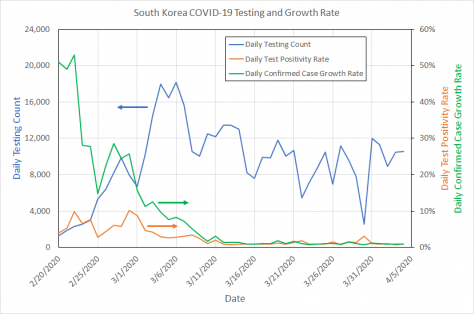
Washington state was one of the first COVID-19 epicenters in the United States in early March 2020. According to the COVID Tracking Project, after the outbreak started, Washington increased the testing faster than the spread of the disease, reducing the positivity rate from 11% down to 8%. The exponential growth of the confirmed cases in Washington slowed down even before the shelter-in-place order was implemented. As shown in Figure 4, Washington state did not continue to ramp up testing dramatically to push the daily test positivity rate lower. The daily confirmed case growth rate stayed at around 10%.
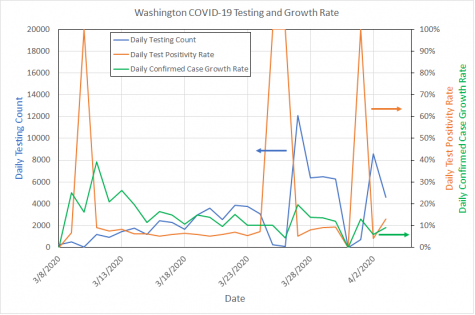
On the other hand, the other two epicenters in early March, California and New York, did not increase testing faster than the spread of COVID-19. This is reflected by the fact that the test positivity rate increased from 10% to 30% in California and from 14% to 38% in New York. Even though the per capita testing number in New York has exceeded that of South Korea, the testing with 38% positivity rate will not be effective in identifying the infected people with mild or no symptoms. This contributed to the fact that New York and New Jersey with test positivity rates greater than 30% have experienced much faster growth in confirmed cases than California and Washington. This also explains that the growth of confirmed cases did not slow down in California even after more than 10 days into shelter-in-place. As shown in Figure 5, the daily test positivity rate reach 50% for several days. At this level, the reported confirmed case is likely limited by the testing capacity, and the reported daily confirmed case growth rate was likely underestimated.
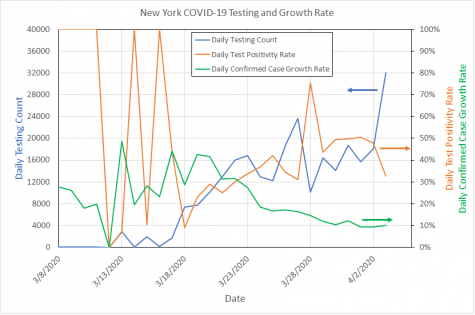
Italy was the first western country to experience an explosive COVID-19 outbreak. The Italian government ramped up testing, but still not fast enough to catch up with the virus spread. The test positivity rate grew from 8% to 19%. However, this rate was lower than those in New York and New Jersey. The number of confirmed cases still grew quickly in Italy, but the growth rate of confirmed cases was lower than those in New York and New Jersey. As shown in Figure 6, Italy ramped up testing to more than 35,000 per day in late March. The daily test positivity rate dropped from 25% down to 12%, and the daily confirmed case growth rate dropped from 15% to 4%. Even though New York, Italy, Washington, South Korea, and Australia have all reached similar per capita COVID-19 testing numbers, it is the test positivity rate that sets apart the growth rate of confirmed cases.
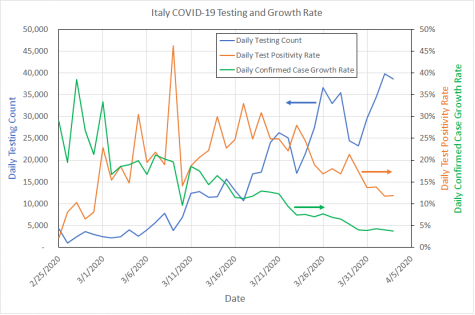
When the COVID-19 outbreak grew out of control, many countries and regions implemented lockdown or shelter-in-place to cut down virus transmission rate. However, this kind of measures severely impact the economy and people’s lives. In terms of controlling the spread of COVID-19, lockdown or shelter-in-place is not as effective as ramping up COVID-19 testing as evident in Australia and South Korea. The key is to ramp up testing faster than the spread of the virus to drive the test positivity rate down to close to 1% in order to identify and isolate the infected people with mild or no symptoms. Then, these people will not continue to spread the disease. The cost of ramping up testing would be far less than the cost of shutting down the entire economy. Shelter-in-place cannot end the crisis. However, if the test positivity rate can be driven down to 1%, the number of infected people and deaths will be dramatically reduced, and shelter-in-place can be lifted.
